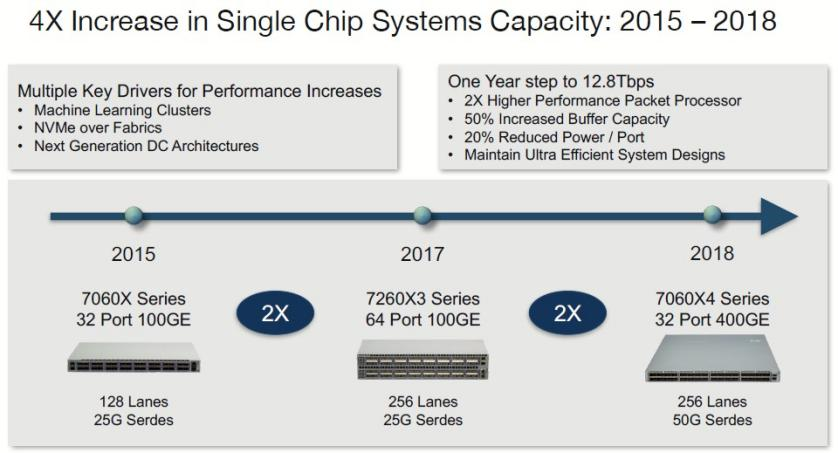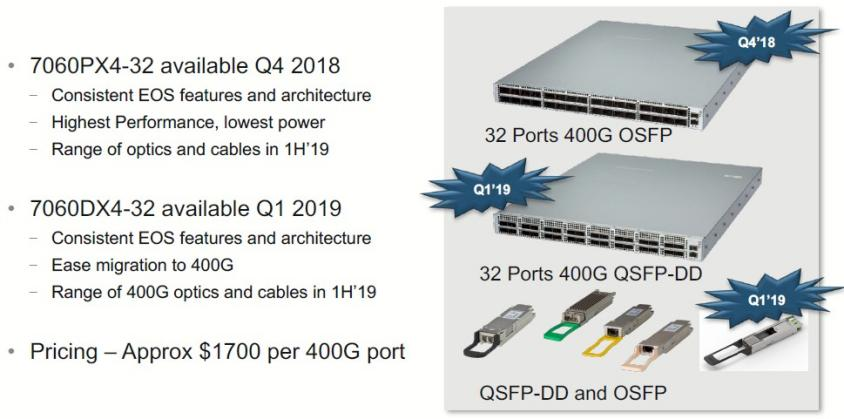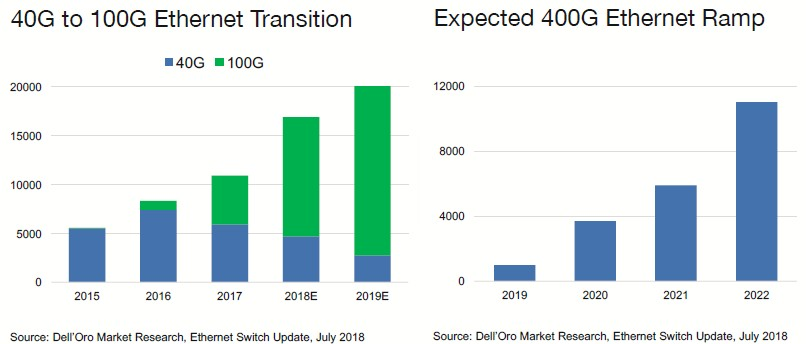
But this is not just about bandwidth. In some cases, hyperscalers, cloud builders, and HPC centers need more bandwidth, as was the base in the intermediate bump from 10 Gb/sec to 100 Gb/sec, where both Ethernet and InfiniBand took an almost half step at 40 Gb/sec to give the industry time to sort out the signaling and optics that would eventually make 100 Gb/sec more affordable than was originally planned. (You can thank the hyperscalers and their relentless pursuit of Moore’s Law for that.)
In many parts of the networks at hyperscalers, there is a need for more bandwidth, but there is also sometimes a need to solder more ports onto a switch ASIC and thereby increase the radix of the device while at the same time creating flatter topologies, thus eliminating switching devices and therefore costs from the network without sacrificing performance or bandwidth.
All of these issues are in consideration as datacenter networking upstart Arista Networks, which has been making waves for the past decade, is the first out the door with switches that make use of the “Tomahawk-3” StrataXGS switch ASIC from merchant silicon juggernaut Broadcom, which we tore the covers off in January of this year.
The Tomahawk-3 ASICs are the first chips from Broadcom to switch from non-zero return (NRZ) encoding, which encodes one bit per signal, to pulse amplitude modulation (PAM) signaling, and in this case Broadcom has PAM-4 encoding which allows for up to two bits per signal and therefore on signaling lanes that run at a physical 25 Gb/sec, they look like they are running at 50 Gb/sec; if you gang up eight lanes of PAM-4 running at that speed, et voila, you have 400 Gb/sec ports. There are a lot of ways that this top end Tomahawk-3 chip, which has an aggregate of 12.8 Tb/sec of bandwidth across its 256 serializer/deserializer (SerDes) circuits, can have its interfaces carved up to link to the outside world – either natively at the chip or using splitter cables at the port. The Tomahawk-3 can carve down those 256 lanes running at an effective 50 Gb/sec to yield ports running natively at 50 Gb/sec, 100 Gb/sec, 200 Gb/sec, or 400 Gb/sec, or customers can use cable splitters to chop the 400 Gb/sec ports down to two running at 200 Gb/sec or four running at 100 Gb/sec.
There is a second Tomahawk-3 variant, which will have only 160 of its 256 SerDes fired up, that Arista is not yet using, and it will 8 Tb/sec of aggregate switching bandwidth that Broadcom suggests can be carved up into 80 ports at 100 Gb/sec; or 48 ports at 100 Gb/sec plus either 8 ports at 400 Gb/sec or 16 ports at 200 Gb/sec; or 96 ports at 50 Gb/sec plus either 8 ports at 400 Gb/sec or 16 ports at 200 Gb/sec. That 80-port setup is important because that is the server density in a rack of hyperscale-style machines that are based on two-socket server sleds that cram four node into a 2U enclosure and twenty of these into a single rack, for a total of 80 ports. Arista’s initial Tomahawk-3 switches are not making use of this cut-down chip, which is obviously going to be made from partially dudded chips as is common among CPU and GPU chip makers that are pushing the envelope on chip making processes and transistor counts.
A QUICK AND BIG JUMP
The line of switches that Arista builds based on Tomahawk ASICs from Broadcom have seen aggregate switching bandwidth on the ASICs go from 3.2 Tb/sec in 2015 to 6.4 Tb/sec in 2015, which is a normal Moore’s Law kind of pace enabled by the shrink from 28 nanometer processes that could put 128 SerDes running at 25 Gb/sec per lane on the Tomahawk-1 that made it into devices in 2015 to the 16 nanometer processes in the Tomahawk-2 that appeared in the Arista line in 2017 with 64 ports running on 256 SerDes running at 25 Gb/sec per lane.

While high radix is important for many, it is not a concern for everyone. Some clustered systems will require the higher bandwidth, and HPC and machine learning shops that can accept an 800 nanosecond port-to-port hop latency (compared to around 100 nanoseconds for 100 Gb/sec InfiniBand or 100 Gb/sec Omni-Path) are going to be able to connect Tomahawk-3 machines up with fewer switches and therefore flatter networks and thereby eliminate some of the hops in the switch fabric and make up for that higher latency compared to really fast Ethernet or blazingly fast InfiniBand or Omni-Path.
Suffice it to say, there are a lot of ways that hyperscalers, cloud builders, and HPC centers might make use of the new Arista 7060X switches. It will all come down to cases, and Martin Hull, vice president of cloud and platform product management at Arista, walked us through some of the math. Let’s say you have 2,048 servers that you want to lash together into a cluster using a single 100 Gb/sec port to the server, to walk through one example of the math that system architects have to do.
“There is no 2,048-port switch out there that runs at 100 Gb/sec per port, so you have to build a topology,” explains Hull. “If you are going to use a fixed 1U switch, with a 32 port by 100 Gb/sec switch, you will need 64 spine switches and 128 leaf switches, for a total of 192 switches, to link those 2,048 servers together. If you take a 32-port switch with 400 Gb/sec ports and have a four-way cable splitter to use it in 128-port mode at 100 Gb/sec, you only need 16 spine switches and 32 leaf switches, for a total of 48 switches. That’s a factor of 4X fewer switches and the cost of the network goes down by a factor of 2.5X.”
That is another way of saying that a 32-port switch with 400 Gb/sec ports is going to cost only around $54,000 compared to around $34,000 for a 32-port switch running at 100 Gb/sec. (That’s single unit list price.) This is the same ratio that we saw with the jump 40 Gb/sec to 100 Gb/sec switches, and in both cases, the higher radix was well worth the money – and you can always take out the splitters and run the switch in 400 Gb/sec mode somewhere down the line. That $1,700 per 400 Gb/sec port is about what a 100 Gb/sec port cost two three years ago.
Back when the Tomahawk-3 was unveiled earlier this year, Broadcom was being cagey about how big the buffers were on this forthcoming ASIC. But now we know, from this comparison table that shows the Tomahawk-2 versus the Tomahawk-3 chip:

In addition to the increase in the throughput and buffer size, the Tomahawk-3 chip has other enhancement to the IPv4 and IPv6 protocol, boosting the longest prefix match (LPM) table sizes as well as doubling the number of members in the Equal Cost Multi Path (ECPM) routing and load balancing.
The Arista 7060X4 switches based on the Tomahawk-3 ASIC come in two flavors, and they differ from each other in the optics that they support. One supports QSFP-DD optics and the other supports OSFP optics.

One of the things that is getting harder to bring down is the amount of heat that 100 Gb/sec ports throw off. With the 7060CX-32 switch based on the Tomahawk-1, the switch burned about 7 watts per port, and with the 7260CX3-64 switch based on the Tomahawk-2, Arista pushed a 100 Gb/sec port down to 5.5 watts. With the 7060X4 switch based on Tomahawk-3, that 100 Gb/sec port runs 5 watts, which is another way of saying that the 400 Gb/sec port is 20 watts. That’s a lot of juice, and that is the price you have to pay for higher bandwidth. But it is definitely less juice per bit transferred, even if the line is flattening out. (Some 7 nanometer chips would help on that front, but that shrink will no doubt be used to get baseline signaling up to 50 Gb/sec and with deeper PAM encoding will drive us up to 800 Gb/sec, 1.6 Tb/sec, and even 3.2 Tb/sec down the road. After that, who knows? 100 Gb/sec signaling looks like a barrier right now.)
The question we have is how quickly can 400 Gb/sec Ethernet ramp. Here’s the best guesses coming out of Dell’Oro:

The initial customers who will be buying 400 Gb/sec Ethernet are, first and foremost, the hyperscalers and some of the larger cloud builders, but Hull says that given the bandwidth available, there will be some HPC centers that go with Ethernet over InfiniBand. Companies building machine learning clusters with very high bandwidth demands – machine learning is worse than HPC when it comes to network load once you scale out beyond one node – are also going to be deploying 400 Gb/sec Ethernet. But probably not the tier two and tier three cloud builders and telcos, and definitely not large enterprises for a while. But, eventually, we will all get there. The economics argue for sooner rather than later.
Opway Profile
Shenzhen OPWAY Communication Co., Ltd is a holding company of Tongyu Communication Inc.(Stock code:002792),OPWAY was established in 2010 with a registered capital of 31 million USD$. In 2014, the company was awarded as a National High-Tech Enterprise.
OPWAY specializes in the development, production and sales of optical communications products.The exsiting staff is over 300 ,we gathered a large number of the senior talents, our products have obtained over 20 patents of invention and practicability.With the high attention of the optical communication industry and years of rich experience, OPWAY can provide full range of optical transceiver products and solutions, the products are widely used in the MAN, LAN, Fiber Channel network,Data Center,FTTx and other fields.Our customers are covered in domestic China , Western Europe, North America, southeast Asia, the commonwealth of independent states (cis), Africa,Middle East, South America and other overseas areas.
The company insists on surviving on quality.We have world-class production and testing equipment from Japan, the United States and other places. We have more than 6400 square meters of 100 thousand grade clean plant in shenzhen headquarter and wuhan R&D and production base.The company strictly checks all aspects of production to ensure the performance and quality of the products to reach the international first-class standard.We have passed ISO9001, OHSAS 18001, ISO14001 and other product certifications including CE, FCC, ROHS, TUV and FDA.Our main products include 100G CFP/CFP2/CFP4/ QSFP28 series, 40G QSFP+ series, 25G SFP28 series,10G SFP+/XFP/X2/XENPAK series, and 1G SFP/1*9 series optical transcivers.
OPWAY takes 'Creating value for customers, Prospects for employees, Benefits for society and Returns for shareholders' as the mission of the company.we promise to provide the high performance,cost effective products with best services and technology support...
For more information,please visit our website:www.opwaytech.com


